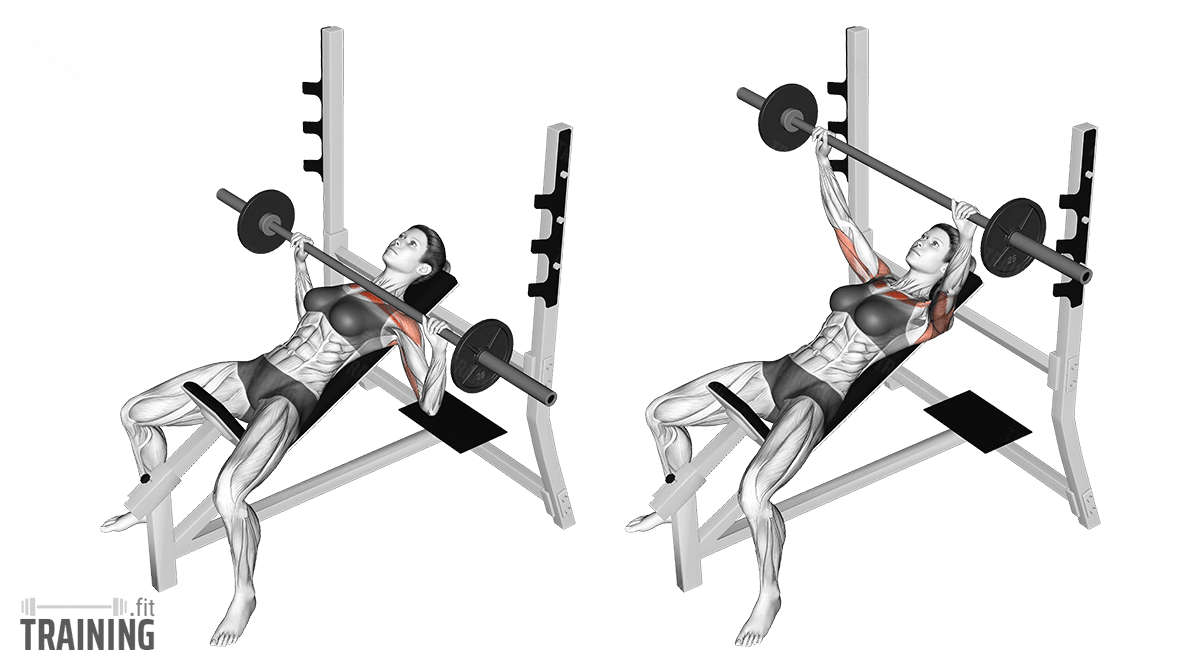Incline Barbell Press
Compound exercise, Free weightsThis article is verified by 3 studies/publications.
Overview

Main muscles
- Chest: Large pectoral muscle
(Musculus pectoralis major) - Chest: Small pectoral muscle
(Musculus pectoralis minor)
Training plans
Here you can find example plans for incline barbell press training:
Incline Barbell Press: Basics and alternatives

Involved main muscle groups:
Incline Barbell Press
The Incline Barbell Press is a variation of the classic flat barbell press. The movement is the same, but the focus shifts to the upper chest muscles due to the inclined position of the weight bench. As you push the barbell away from your chest, you’ll engage your chest, shoulders, and triceps.
To train your upper chest muscles, you can also try incline chest exercises like the incline bench press, incline fly, or incline cable fly. Dips are another excellent option for activating the upper chest [1].
Correct Execution
The angle of the incline bench for the Incline Barbell Press is often set to 45 degrees. Some benches allow you to adjust the angle; if not, you can use a free weight bench in a power rack and choose the angle yourself.
The optimal incline angle varies depending on who you ask. Some people prefer 45 degrees, others suggest 15 to 30 degrees, while some say 55 degrees works best.
Research also offers different perspectives: a 2010 study found greater activation of the clavicular part of the pectoral muscle at 44 degrees than at 28 degrees [2], while a 2015 study measured higher activation of the upper chest muscle at 30 degrees (compared to 45 degrees) in some movement areas [3].
What’s clear is that a steeper incline puts more strain on the front shoulder, so depending on your training plan and goals, a 30 or 45-degree incline can be equally effective. It’s best to try both options and choose the one that feels best for your muscles.
Video Tutorial
Step-by-Step Instructions
Lie down on the incline bench with your back.
Plant your feet firmly on the ground and press your chest and back into the padding.
Pull your shoulder blades together and create a slight arch in your back.
Extend your arms straight up and grab the bar with a shoulder-width grip. Your palms should be facing away from you. For safety, wrap your thumbs around the bar instead of placing them next to your fingers.
Lift the bar vertically up from the holder. Then position the bar directly above your chest, keeping your arms extended. You’re now in the starting position.
Slowly and controlled, lower the barbell down. It should come down below your chin, about level with the upper chest (not at neck level). Don’t flare your elbows too much; instead, try to keep them at an angle of about 45 degrees beside your body.
Pause just above your chest for a brief moment.
Push the barbell back up to the starting position.
Common Mistakes and Injuries
As with the regular bench press, avoid using a monkey grip. Instead, grip the barbell with your thumbs during the Incline Barbell Press to prevent it from rolling forward.
A possible error in posture can be lifting your hips. By raising your hips, the angle between your arms and shoulders decreases, turning the Incline Barbell Press more into a flat bench press without stable posture. Make sure to maintain your starting position and keep your buttocks and upper body pressed against the bench. If the angle is too high or the weight is too heavy, reduce both and only increase the weight when you’ve mastered the proper form.
Throughout the exercise, keep your shoulder blades pulled together and don’t extend them. This ensures a clean form for your chest and lower back.
Sources
- Inside the Muscles: Best Chest and Triceps Exercises. Bret Contreras. T Nation. 02/22/10. https://www.t-nation.com/training/inside-the-muscles-best-chest-and-triceps-exercises, retrieved 30.08.2021
- An electromyography analysis of 3 muscles surrounding the shoulder joint during the performance of a chest press exercise at several angles. Arthur A Trebs, Jason P Brandenburg, William A Pitney. J Strength Cond Res. 2010. https://pubmed.ncbi.nlm.nih.gov/20512064/, retrieved 30.08.2021
- Influence of bench angle on upper extremity muscular activation during bench press exercise. Lauver, Cayot, Scheuermann. European Journal of Sport Science. 2015. https://www.tandfonline.com/doi/full/10.1080/17461391.2015.1022605, retrieved 30.08.2021